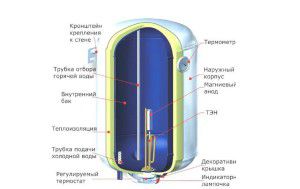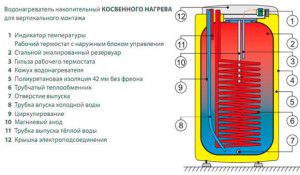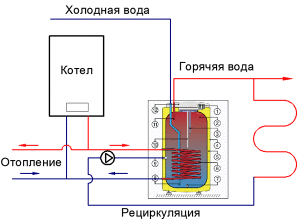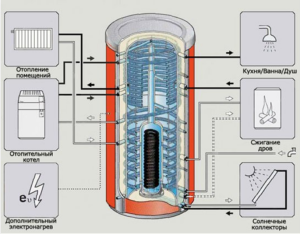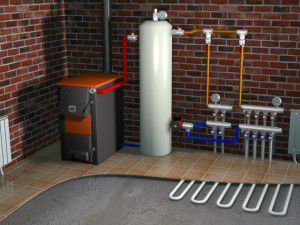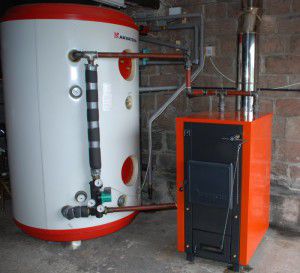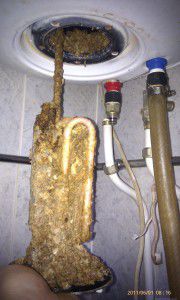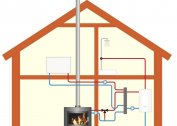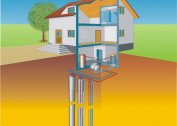Almost every house or apartment has a boiler for hot water supply. And sooner or later a reasonable question arises - can it be used for heating? To solve it, you need to know the specifics of the operation and operation of this device. Let us analyze - in what cases they use a boiler in the heating system of a private house: schemes, calculations, connection.
Boiler as a source of water heating
The classic boiler is a sealed container, inside which is located an electric heating element. To connect to the water supply system in the design provides 2 pairs. Can a similar boiler be used in the heating system of a private house?
Alas, it does not have the necessary characteristics necessary for organizing autonomous heat supply. For normal operation, a boiler for heating a private house must have a very high power. On average, 1 kW of heat energy is needed per 10 m² of living space. Those. To heat a house of 100 m², a boiler model with a minimum power value of 10 kW is required. Manufacturers simply do not produce such models.
If you use a boiler to heat a cottage with a small area, you may encounter the following problems:
- High inertia. On average, a tank of 100 liters. at a power of TENA 2 kW will be heated to a temperature of + 75 ° C for 1.5-2 hours. In this case, circulation will be impossible, since it will only increase the heating time;
- Large tank volume. In theory, it makes it possible to use the boiler for heating and hot water. However, constant water intake and replenishment of the system from the outside will lead to uneven heating of the coolant;
- High power consumption. Before making heating from a boiler, it is necessary to calculate its power. It should be borne in mind that its use in hot water supply will lead to constantly switched on heating elements. Thus, the cost of electricity will increase.
So why in the network are more and more common schemes in which heating is carried out using a boiler? After all, it is much more rational to use an electric boiler for this. It's all about the wrong terminology. In water heating, it is possible to install the so-called indirect heating tanks, which are structurally similar to boilers. To avoid further confusion, we will also call them boilers.
If you want to install a classic boiler as the main heating element, there may be problems with the manufacturer's warranty. This is due to a malfunction of the device.
Storage tank as an alternative to a traditional boiler
The storage tank is structurally almost completely similar to a classic boiler. The difference lies in the internal pipeline, which is connected to the heating system. In this case, it is necessary to solve the question - why do we need a boiler in the heating system?
Properly organized heating through the boiler suggests that this element will serve as a heat accumulator. Water that is in the tank receives thermal energy through an internal coil connected to the heating system. After shutting down the boiler, the reverse process will occur - an increase in the temperature of the coolant from the water in the boiler.
In addition, after the boiler has been correctly connected to the heating system, it will be able to perform the following functions:
- Organization of hot water supply. Since the liquid from the tank does not come into contact with the coolant, it can be used on the farm. But for this it is necessary to make the correct calculation of the boiler power for heating the house, so that this does not affect the parameters of heat supply;
- Heated water using the built-in heating element. Thus, it is possible to maintain the level of heating of the coolant even with an inactive boiler. This can only be done by purchasing an electric boiler for heating.
It is important to initially determine the purpose of the storage tank - it will be designed for domestic hot water, work as a heat accumulator, or combine these functions. Based on the decision, the optimal volume is calculated and the heating scheme from the boiler is selected.
The storage tank can be made independently. To reduce heat loss, it is necessary to make the insulation of the case.
Calculation of the volume of the storage tank and the power of the heating element
At the first stage, it is necessary to calculate the capacity of the boiler for heating the house. There are several ways to solve this problem. The most optimal of them is to get acquainted with the recommendations from the manufacturer of a specific tank model.
It must be taken into account that the heating circuit from the boiler directly depends on the power of the entire system. Therefore, this value is taken as the initial parameter. Suppose it is 1 kV / h. After installing the boiler in the heating system of a private house, it must maintain an optimal level of water heating for another 5 hours. Moreover, the thermal regime of the system is 75/50 (low temperature). In this case, the optimal volume of the boiler for heating and hot water is calculated by the following formula:
V = 5 / (75-50) = 0.5 m³ or 500 l
The resulting volume can be reduced if you purchase a boiler model for heating a cottage with a heating element. Then, in the calculation, the specific power of this device must be taken into account. On average, to ensure full-fledged operation of heating with the boiler turned off and the average rate of hot water consumption (10 l / h), it is necessary to purchase a model with a volume of about 400-450 l.
For a complete calculation of the boiler power for heating a house, all factors must be taken into account - heat losses in the building, location of the tank in the system, etc.
Installation and operation of a heating boiler
After performing all the necessary calculations of the boiler power and its volume, you can proceed to integrate the device into the heating system. An important task is to determine the installation location. Having decided on the purpose of the boiler in the heating system, you need to read the instructions for its installation. The best option would be to install in the immediate vicinity of the boiler. In this case, the transfer of thermal energy from the coolant to the water is most effective.
But at the same time, you can encounter the following difficulties in organizing heating with a boiler:
- DHW supply. In a heating system with a solid fuel boiler, it is most convenient to place a boiler directly in the boiler room. But then, to supply heated water to the premises, you need a separate pump and control devices for it;
- Large capacityif it is planned to heat through a boiler for large living spaces. There is a problem with the placement of the heating element;
- Supply of electricity to ensure the operation of the heating element. For the normal functioning of the boiler for heating a private house, it is also recommended to install an autonomous source of electricity.
Having solved these issues, you can proceed directly to the installation.
Monitoring the temperature of water in the heating through the boiler is carried out using an installed thermometer.It is not included in the standard package and therefore it is necessary to purchase this device separately.
Installing a heating storage tank
To install the heat accumulator, it is necessary to prepare a flat area in advance. Its heavy weight should be taken into account - in case of need a separate foundation is made or floors are strengthened.
The best option for installation is on a separate platform. This way you can avoid contact of the casing with the concrete surface, which will reduce the heat loss in the electric boiler for heating. Almost all manufacturers make containers on special legs. In case of their absence, it is recommended to install a heater on the floor.
The procedure for connecting the boiler to the heating system is to perform the following actions:
- After installing the tank, you need to check its position relative to the horizon. No deviations allowed.
- Connect to heating. It is important that the diameter of the nozzles is equal. Otherwise, after connecting the boiler to the heating system, excessive hydraulic resistance will appear.
- If installation is carried out in an unheated room - the boiler body is insulated.
- A connection is made to the hot water supply so that the boiler works not only for heating, but also for domestic hot water.
Upon completion of this work, it is necessary to check the tightness of all connections and start the heating system. Within 2-3 weeks, it is recommended to take measurements of the temperature of the water in the tank and the coolant in the pipes after turning off the boiler. So you can determine the actual time to maintain the desired heating level in the heating circuit from the boiler.
In order to make full heating from the boiler, it is not recommended to use antifreeze. It is characterized by a relatively low heat capacity, which will affect the transfer of heat to water and back to the coolant.
Proper boiler operation conditions
Serving a storage tank is practically no different from carrying out the necessary procedures to maintain the operability of any electric boiler with heating elements. And in this case, in order for the boiler to work normally in the heating system of a private house - you need to follow the manufacturer's recommendations.
This can be ensured even before the heat supply from the boiler is done. It is best to purchase models with the so-called “dry heater”. On it, scale formation is much slower. You should also pre-filter the water before feeding it into the storage tank.
In addition to these procedures, you must do the following:
- Once a month, check the integrity of the thermal insulation of the structure;
- Monitor the duration of maintaining the temperature of the coolant during the mode of operation of the heat supply through the boiler. The difference between the calculated and actual indicators should not exceed 15%;
- Connection tightness control. It is recommended that the gaskets be replaced before each heating season. So you can achieve more reliable heating of a private house with a boiler.
The control unit of some models is sensitive to voltage surges. In order to avoid damage to this expensive device, a stabilizer for the boiler in the heating system should be connected.
To clean the heater from scale, it must be dismantled. But before that, you need to find out from the seller whether the factory warranty will be preserved.
Do-it-yourself boiler for heating
It should be noted that the cost of factory models of a boiler for heating a summer cottage is quite high - from 7000 rubles. and more. An alternative is to make the structure on your own.
To do this, you can use any steel tank. It is important that its volume corresponds to the calculated one. To organize heat supply schemes from a home-made boiler, the following components will be needed:
- Tank. It is best to order a stainless steel structure or make one yourself. On the case there should be holes for soldering the inlet and outlet pipes;
- Coil. The best option is to install a copper structure. This material has optimal parameters for the transfer of thermal energy;
- Attachment of pipes for heating and domestic hot water.
To ensure thermal insulation, it is recommended to make a double case. Glass wool or basalt insulation is installed between the walls. The recommended layer thickness is 5 cm. The installation and commissioning procedure is no different from the factory models.
How efficient is the use of a boiler in heating a house? It all depends on the correct calculation of the parameters of the entire system. Only after calculating the optimal characteristics and testing them in practice can we talk about the real effectiveness of the boiler installation.
The video footage shows an example of the use of a boiler in a heating system.
